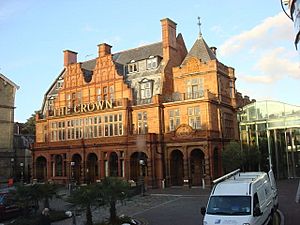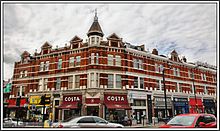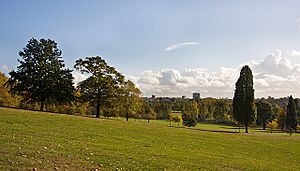Cricklewood facts for kids
Quick facts for kids Cricklewood |
|
|---|---|
 Clayton Crown Hotel, Cricklewood |
|
| OS grid reference | TQ235855 |
| London borough | |
| Ceremonial county | Greater London |
| Region | |
| Country | England |
| Sovereign state | United Kingdom |
| Post town | LONDON |
| Postcode district | NW2 |
| Dialling code | 020 |
| Police | Metropolitan |
| Fire | London |
| Ambulance | London |
| EU Parliament | London |
| UK Parliament |
|
| London Assembly |
|
Cricklewood is a lively area in London, England. It sits right on the border between two London boroughs: Barnet to the east and Brent to the west. A famous building here is the Crown pub, now called the Clayton Crown Hotel. It is about 5 miles (8 km) north-west of Charing Cross, a central point in London.
Long ago, Cricklewood was just a tiny village. It grew up around Edgware Road, an old Roman road also known as Watling Street. This road still divides the two boroughs that share Cricklewood. The area started to grow much bigger in the 1870s. This happened when surface and underground trains arrived nearby at Willesden Green. Today, Cricklewood Broadway, which is part of Edgware Road, is full of shops. The streets around it are quieter, with many homes built in the late 1800s and early 1900s. Cricklewood has strong ties to Ireland because many Irish people have made it their home. A large green space called Gladstone Park is on the western edge of the area.
Cricklewood has two special areas that are protected for their history and looks: the Mapesbury Estate and the Cricklewood Railway Terraces. In 2012, the Mayor of London gave Cricklewood £1.65 million to make the area even better.
Contents
History of Cricklewood
How Cricklewood Started
The small village of Cricklewood began around 1294. By 1321, it was officially known as Cricklewood. The name came from a nearby wood, possibly on Cricklewood Lane. The name "Cricklewood" might mean "hill hill wood." This is because it combines an old British word cruc (meaning hill) with an Old English word hyll (also meaning hill).
The area east of Watling Street was part of the old parish of Hendon. This is now in the Barnet borough. The area to the west was in the old parish of Willesden. This is now part of the Brent borough.
By the 1750s, the Crown pub was a popular stop for people traveling by coach. The pub was rebuilt in 1889. In the 1800s, a few cottages and Cricklewood House were built nearby. The Crown pub was also known for its "pleasure gardens." By the 1860s, several large houses appeared along Edgware Road.
Growing East of Edgware Road
The Cricklewood railway station opened in 1868. In 1881, the Midland Railway Company moved its train repair workshops to "Brent Sidings." They also announced that new homes for their workers would be built. These homes are now known as the Railway Cottages. Mr. H. Finch built a few streets behind the Crown Inn in 1880. These included Yew, Ash, and Elm Groves. By 1884, Cricklewood station was the end stop for Midland Railway's local train services.
By 1881, the population had grown enough for a new church. St. Peter's Church was built in 1891, replacing an older tin chapel. The London General Omnibus Company started bus services from the Crown pub to Regent Street in 1883. In 1899, they opened a bus garage. This garage is still used today and was completely rebuilt in 2010.
By the 1890s, houses and shops lined parts of Cricklewood Lane. Cricklewood Broadway became a busy shopping area by 1900. The Queens Hall Cinema, later called the Gaumont, replaced Rock Hall House. It was torn down in 1960. More roads like Thorverton, Caddington, and Dersingham Roads were built in 1907. This was the same year Golders Green Underground station opened.
Cowhouse Farm, later called Dicker's Farm and then Avenue Farm, closed in 1932. From 1908 to 1935, Westcroft Farm was a home for horses. It could house up to 250 horses. The Metropolitan Borough of Hampstead opened the Westcroft Estate in 1935.
Growing West of Edgware Road
Much of the land west of Edgware Road belonged to All Souls College, Oxford. This area used to have many trees. In 1662, there were 79 oak trees in Cricklewood. The area really changed when the underground station opened in Willesden Green in 1879. From 1894 to 1938, it was known as Willesden Green and Cricklewood station.
Many builders bought land and built houses in the 1890s and early 1900s. George Furness developed an area he called Cricklewood Park between 1893 and 1900. The roads there are named after trees, like Pine, Larch, Cedar, Ivy, and Olive. The name Cricklewood Park is not used anymore.
South of this area, Henry Corsellis built Rockhall, Oaklands, and Howard Roads starting in 1894. All Souls' College built a group of roads named after important people from the college. For example, Chichele Road is named after Henry Chichele, who founded All Souls' College. Further west, building was stopped by the Dollis Hill estate. This estate became a public park, Gladstone Park, in 1901. To the north of Furness's Cricklewood Park Estate, Earl Temple built Temple Road by 1906 and other nearby roads. To the south, the Mapesbury Estate was built mostly between 1895 and 1905. It is a protected area with many semi-detached and detached houses.
Cricklewood's Industrial Past
With the arrival of trams in 1904 and more buses by 1911, many important businesses started in Cricklewood.
- The Phoenix Telephone Company began in 1911.
- The Handley Page Aircraft Company was here from 1912 to 1917. They had a factory on Claremont Road. The Cricklewood Aerodrome next to their factory was used for the first London-Paris air service in the 1920s.
- The old aircraft factory became Cricklewood Studios in 1920. This was the biggest film studio in the country at the time. It made many silent films. The studio closed in 1938. Today, a Wickes DIY store stands on that property.
There were plans around 1900 to extend the London Underground to Cricklewood. Several ideas were suggested, including an underground railway tunnel under Edgware Road. One unusual plan was for a type of underground monorail roller-coaster! However, these plans were never built.
Cricklewood was also home to Smith's Industries. This company started in 1915 on Edgware Road. They made fuses, instruments, and other parts. By 1939, they were making electric motors, aircraft parts, and electric clocks. A large sign for the company on the railway bridge over the Broadway was a famous landmark for many years. Cricklewood was the most important site for the company, with 8,000 employees between 1937 and 1978.
Interestingly, Cricklewood also had the first factory for Smith's Crisps potato chips. This factory took over the old bus depot at Crown Yard. After moving to new buildings, the yard was used by Clang Electrical Goods Ltd. from 1929 to 1933.
Bentley Motors, famous for racing and sports cars, built a factory at Oxgate Lane in 1920. Cricklewood was their main office until Rolls-Royce bought them in 1931.
From the 1960s, many of these industries in Cricklewood started to decline. All the businesses mentioned above have now left the area.
There were two important buildings on Cricklewood Lane. One of them still exists. The first was Production Village, which was part of the British film industry. It later became a pub with rehearsal rooms. On the same site was Clang's electrical company from 1929 to the mid-1970s. Production Village was torn down in 2000 and became a gym.
Further up the hill on the south side of the road is a modern building. This was the factory that made the amazing Stylophone. This was a handheld electronic organ popular in the late 1960s and early 1970s.
In June 2001, a lynx (a type of wild cat) was caught in Cricklewood. People had reported seeing it for 10 years! The local newspapers called it the "Beast of Barnet." A vet from the London Zoological Society used a tranquilizer gun to safely catch the animal. It is thought that someone was keeping the lynx illegally and it had escaped. The lynx was taken to London Zoo and named Lara.
Recent Changes in Cricklewood
The Brent Cross Cricklewood project is a huge plan to redevelop Cricklewood, Brent Cross, and West Hendon. It was approved in October 2010 and is expected to cost £4.5 billion. A new Brent Cross Thameslink station is planned. Because of this, plans to make the Cricklewood station platforms longer were stopped. This is currently the biggest planned development in London.
The approval for this project was delayed for several years. This was because some people were for it, and some were against it. Local and national news reported on these discussions.
Fun Things to Do in Cricklewood
Parks and Gardens
The Mapesbury Dell on Hoveden Road is a small park and garden. Local residents manage it. It started in 2000 when people living nearby decided their green space was too important to ignore. The dell is open to everyone during the day. It is used all year, for example, for carol singing in December.
Gladstone Park is on the north-western edge of Cricklewood. It covers about 35 hectares (86 acres). In 2003–04, the park was improved with money from the Heritage Lottery Fund. The park has a beautiful formal garden, a playground for children, an art gallery, a café, and a pond. It also has great sports facilities for football, rugby, cricket, tennis, and netball. On clear days, you can see Wembley Stadium, the London Eye, and the Shard from the park's highest point. The famous writer Mark Twain often visited the park around 1900. He stayed at Dollis Hill House nearby. He said he had "never seen any place that was so satisfactorily situated."
Famous Buildings
The historic Crown pub is a beautiful Victorian building on Cricklewood Broadway. It was built in 1899 by architects Shoebridge & Rising. It was fully restored in 2003 and reopened as the Crown Moran Hotel. It now has a 152-room hotel and a restaurant. Later, it was renamed the Clayton Crown Hotel. The building has a unique style with stepped gables and lots of decorative terracotta.
Another important local building is the Cricklewood Baptist Church. It is on Anson Road at the corner of Sneyd Road. The church was built in 1907 using red and yellow brick in an Italian Byzantine style. Other local churches include St Gabriel's Church on Walm Lane and Claremont Free Church on Cheviot Gardens. St. Agnes' Roman Catholic Church was built in 1883 on Cricklewood Lane. St. Agnes' Catholic Primary school is next door. Both serve the large Catholic community in the area.
Cricklewood Pumping Station was built in 1905. It is another special building. The inside of this building was used in the 1997 film Titanic to look like the ship's engine rooms.
Local Groups and Associations
In June 2012, the Cricklewood Town Team received £1.67 million from the Mayor of London. This money was to help improve the local high street, create new jobs, and make life better for people. The funds also helped pay for annual summer and winter festivals until 2017. An OMG comedy club was also started to add to the local culture.
Several groups of residents are active in the area:
- The NorthWestTwo Residents Association
- The Mapesbury Residents Association
- The Groves Residents Association
- The Railway Cottages Association
A group of local artists created Creative Cricklewood. The Clitterhouse Farm Project is a group working to save and restore the old Clitterhouse Farm buildings. These are on the corner of Clitterhouse Playing Fields on Claremont Road. They want to use the farm as a place to promote culture and community.
Cricklewood's Location
 |
West Hendon | Brent Cross | Golders Green |  |
| Dollis Hill | Childs Hill | |||
| Willesden | Brondesbury | West Hampstead |
Getting Around Cricklewood
Train Stations (Thameslink)
Cricklewood station is in Zone 3. It is the closest main-line station. You can catch Thameslink trains from here.
- To St Pancras (where Eurostar trains leave from) in about 10 minutes.
- To Farringdon station in 16 minutes.
- To Luton Airport in 35 minutes.
There is a large railway complex and sidings north of the station.
Brent Cross West station is being built in the north of the area. It will also offer Thameslink services starting in late 2023.
Underground Stations (Tube)
Willesden Green and Kilburn stations are both on the Jubilee line in Zone 2. They are about a 15-minute walk from Cricklewood Broadway.
- To Baker Street in 11 minutes.
- To Westminster in 17 minutes.
Overground Station
Brondesbury station is in Zone 2 on the London Overground. It is also about a 15-minute walk from the Broadway.
- To Hampstead Heath in 6 minutes.
Roads
Cricklewood Broadway is the main road that runs north to south through the area. It is part of the Edgware Road, which goes straight to Marble Arch. Marble Arch is located between Oxford Street and Hyde Park.
Buses
Cricklewood has a bus garage that was completely rebuilt in 2010. This means many bus routes start or pass through the area. You can find frequent buses to places like Victoria, Acton High Street, Oxford Street, Brent Cross, and Golders Green.
Famous People from Cricklewood
Many well-known people have lived in or have connections to Cricklewood:
- Elizabeth Adare – TV actress
- Emma Anderson – guitarist and songwriter
- Tim Brooke-Taylor – TV actor
- Jamie Cho – actor
- Alan Coren – writer and humorist
- Nick Frost – actor and comedian
- Tamsin Greig – actress
- Ching He Huang – TV chef
- Dave Kaye – pianist
- Shaun Keaveny – radio DJ and comedian
- Elihu Lauterpacht – academic and lawyer
- Ken Livingstone – former Mayor of London
- Phil Lynott – lead singer of Thin Lizzy
- Penelope Mortimer – novelist
- Róisín Murphy – musician
- Jimmy Nail – TV actor
- Peter O'Toole – actor
- Simon Pegg – actor and comedian
- Oliver Sacks – neurologist and author
- Zadie Smith – author
- Dean Stalham – artist
- Philip Sugden – historian
- Marti Webb – musical theatre actress
Cricklewood in Books and TV
Cricklewood has appeared in many books, TV shows, and songs:
- It is the setting for parts of Zadie Smith's novel White Teeth. It also appears in her book On Beauty.
- The writer Alan Coren dedicated several of his books to Cricklewood, like the Cricklewood Tapestry.
- The fictional Cricklewood Film Studios are featured in Peter Capaldi's spoof documentary Cricklewood Greats.
- The real Stoll Film Studios (also known as Cricklewood Studios) were located here.
- It was the setting for the TV show The Goodies.
- The Crown pub on Cricklewood Broadway was shown in the opening credits of the TV series Minder.
- The album by Ten Years After is called Cricklewood Green.
- Cricklewood is mentioned in the Irish folk song 'McAlpine's Fusiliers'.
- Gary Sparrow's home in the 1990s BBC sitcom Goodnight Sweetheart is in Cricklewood.
- The famous comedian Eric Morecambe once said, "life's not Hollywood, it's Cricklewood."
- Cricklewood is mentioned in the song "Willesden to Cricklewood" by Joe Strummer (from the Clash).
- John Betjeman, a famous poet, mentions Cricklewood and the Crown pub in his 1968 poem, 'Ho to the Kilburn High Road!'. He writes about the village marketplace and electric trams that used to be there.
Films Made at Cricklewood Studios
Some films were made at the real Cricklewood Studios:
- 1927: Huntingtower directed by George Pearson
You can find more films listed at Cricklewood Studios films.
Images for kids
See also
 In Spanish: Cricklewood para niños
In Spanish: Cricklewood para niños










